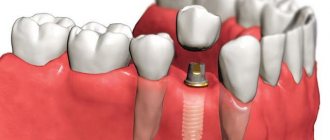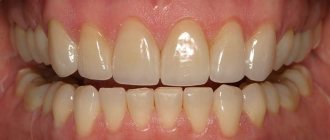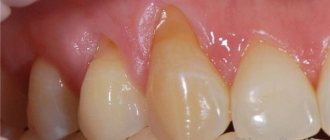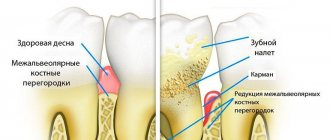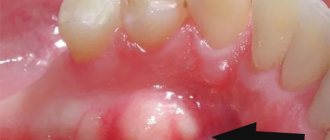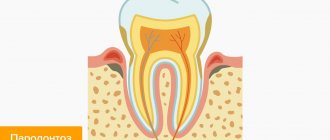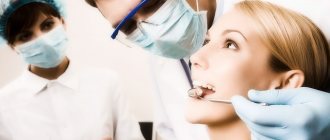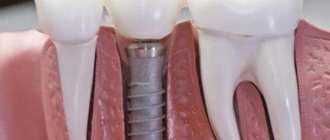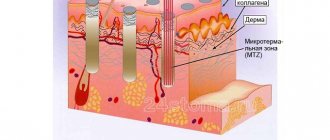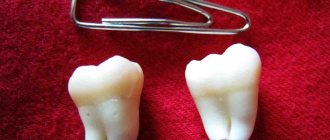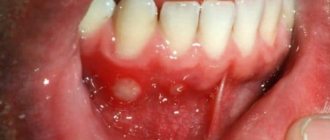Causes of Gum Tissue Recession
In addition to aesthetic discomfort, periodontal recession threatens a number of diseases, including loss of healthy teeth. The problem can occur in one or several teeth at once. The recession manifests itself unnoticed; for a long time the patient does not feel symptoms, apart from slight discomfort during routine brushing of teeth from plaque and eating.
Periodontal detachment is provoked by the following reasons:
- features of jaw anatomy,
- various periodontal diseases,
- tooth extraction, tooth loss,
- improper hygiene,
- heredity,
- age changes,
- bad habits, not only smoking, but also eating seeds.
Due to tooth loss, the structure of the gums changes and there is not enough chewing load. Tissues atrophy, their volume decreases.
Dental implantation and bone grafting
Gum augmentation during implantation will be carried out exclusively in cases where its volume is not enough to carry out the procedure. In this case, bone grafting is used using any of the methods proposed by a professional: regeneration, grafting, sinus lifting.
Two implants were installed in the sockets of previously extracted teeth
Why is this necessary, you ask? Everything is elementary simple: the volume of tissue must be in sufficient quantity because otherwise, the implant may move, which will result in irreversible processes and negative consequences.
If the procedure is carried out correctly, the gums will not sag down, and the metal part of the foreign body will not be exposed.
How to determine whether gum augmentation is needed
The procedure is carried out with the aim of restoring periodontal health and improving the aesthetic component. Extension is indicated for:
- periodontitis and periodontal disease,
- implantation and prosthetics,
- malocclusion.
Thanks to tissue correction, root caries can be prevented. If a patient has advanced periodontal disease and the gum pockets cannot be corrected, regeneration will help to obtain periodontal volume around the teeth. After the procedure, the sensitivity of the enamel to hot and cold foods will disappear.
Regarding aesthetic purposes, periodontal augmentation is indicated for:
- atypical gum contour,
- mechanical injury,
- pathological changes in tissues from addictions.
Thanks to aesthetic plastic surgery, an even periodontal contour is formed, and the patient receives an attractive smile.
In what cases is extension necessary?
Answering the question posed, it is reasonable to note that gum regeneration may be required for both medicinal and aesthetic purposes. If we list the situations in which such a build-up is mandatory, then first of all these include:
- the patient has periodontal disease or periodontitis;
- violation of teeth closure (bad bite);
- use of implants or prostheses.
By achieving proper restoration of gum tissue, you can minimize the likelihood of developing root caries and guarantee the safety of your teeth. In addition, solving the problem under consideration normalizes the sensitivity of the latter, thereby relieving a person of discomfort when eating cold or hot food.
Restoration of gum tissue
It is also worth noting that gum augmentation may be required in other cases - when tissues affected by a pathological process need to be restored for aesthetic purposes. For example, regeneration is justified if:
- gums have irregular contours;
- soft tissues are damaged due to certain bad habits;
- gums are injured as a result of mechanical stress.
Practice shows that gum augmentation, done correctly, allows you to return their contours to their former beauty. Thus, upon completion of all necessary procedures, a person can enjoy life again, without any fear for the aesthetics of his smile.
Recovery methods
Surgical surgery is carried out taking into account the degree of soft tissue deficiency. When the cause of exposed gums is bone atrophy, bone mass is initially increased.
There are several effective methods:
- regeneration,
- block replanting,
- plastic surgery,
- sinus lift.
Before surgery, the doctor assesses the patient’s health and checks for allergies. During the procedure, an autograft can be used - a flap of the patient's mucosa / biomaterial created artificially. This material will become a catalyst for periodontal growth.
Dentists prefer to use biomaterial made from artificial fibers, because... when an autograft is used, the operation will have to be performed twice - first, the collection of donor material, then its implantation. After taking your own tissue, a postoperative scar remains; there is a risk of an inflammatory process, which requires additional therapy.
Gum restoration at home
You can restore a beautiful, healthy smile yourself at home after consulting a dentist. If your teeth begin to become exposed at the roots, you need to stock up on the following accessories:
- a toothbrush with soft bristles,
- pharmaceutical medicinal ointment,
- paste intended for periodontal therapy,
- decoctions of plants (oak and nettle, and also chamomile, sage),
- sea buckthorn and olive oil.
A prerequisite for gum treatment includes the use of brushes with soft bristles, excluding tissue trauma. When cleaning the enamel, you need to carefully move the brush. From time to time, you need to rinse your mouth with medicinal decoctions, and before going to bed, massage the area around your teeth with oil.
The massage is not difficult to do - soak a cotton pad in oil and then massage the mucous membrane around the tooth. It stimulates blood circulation and periodontal growth. An additional benefit will come from massaging the gums with a simple, affordable paste - in a small container, mix a couple of pinches of soda with water until you get a white paste. Dip your finger into the mixture, gently massage the mucous membrane in a circle, then rinse the mouth.
Thanks to soda you can:
- normalize the alkaline balance in the oral cavity,
- reduce the activity of pathogenic bacteria,
- improve blood circulation,
- normalize the volume of gum tissue.
Treatment can be supplemented by taking vitamins C, B9, D.
Is it possible to restore gums on your own?
Treatment of periodontal disease can be performed not only by surgical methods. If the disease has not reached an advanced stage, you can increase the volume of gum tissue yourself. The therapy includes the following elements:
- a toothbrush made of soft material that does not injure the gums;
- gel or ointment for gums;
- toothpaste for the treatment of periodontal disease;
- decoctions of medicinal herbs;
- olive or sea buckthorn oil.
If you previously used a brush made of hard material, it must be replaced with a new one. The bristles should be soft and not injure the gums. When brushing your teeth, you should perform light movements from top to bottom. Throughout the day you need to rinse your mouth with a decoction of chamomile, sage, and calendula.
Before going to bed, after brushing your teeth, you need to massage your gums by applying oil to them. You will need to soak a piece of cotton wool in oil and perform a massage in a circular motion. With regular implementation of the procedure, the condition of the gum tissue improves significantly, as blood circulation and tissue nutrition are normalized.
Particular attention should be paid to the choice of toothpaste for periodontal disease.
Massage can be done using table paste. You need to dilute the baking soda with water until you get a thick consistency, then wet your finger in the product and massage your gums. Soda helps restore alkaline balance, destroys pathogenic microflora and improves blood circulation. Treatment should include taking vitamins B, C and D, which help strengthen gum tissue.
It is important to consult a doctor to determine the extent of the disease, as well as the method of treatment. Self-treatment of periodontal disease can lead to negative consequences.
Gum augmentation for periodontal disease is required already at advanced stages, so it is better to start treatment on time and avoid such a procedure.
Possible complications
It is important to respond to pathologies in a timely manner, since inflammation does not go away without a trace. Advanced pathology leads to gingivitis, an inflammatory process of the periodontium. Minor redness should already be eliminated with herbal decoctions.
You will need a pinch of any medicinal herb - sage, St. John's wort, chamomile. You need to pour the herb into a cup, pour boiling water over it, leave for 10 minutes. Rinse your mouth with this decoction several times a day. Other products suitable for rinsing:
- furatsilin solution (prepared from tablets),
- hydrogen peroxide (ready or diluted),
- calendula tincture,
- Asept ointment,
- Chlorhexidine,
- dental ointment Cholisal,
- Kamistad ointment.
It is not difficult to prepare solutions before rinsing. 1 tsp peroxides are diluted in 100 ml of water. Two Furacilin tablets are diluted in 1 glass of warm water. When the disease worsens, rinsing is done every hour.
The rinsing procedure is alternated with the application of medicinal ointments. Cholisal is approved for use in young children because it does not have aggressive ingredients. The ointment has antimicrobial properties, relieves swelling and pain.
Asepta contains propolis, this ointment has a regenerating, antimicrobial effect. The product contains antibacterial components.
Prevention after surgery
The procedure for gum augmentation is complex; it is advisable to do everything possible to prevent pathology from developing.
Taking care of the oral mucosa and dental health will help prevent this.
The following recommendations will be useful:
- diversify your diet, enrich it with foods with vitamins,
- eat raw vegetables and fruits to train your gums and give your teeth the necessary load,
- consume vitamin C,
- strengthen the immune system with walks, nutrition, hardening,
- avoid stress, strengthen the nervous system,
- dress according to the weather, avoiding hypothermia,
- eliminate dental problems in a timely manner,
- maintain hygiene - brush your teeth and tongue in the morning, evening,
- preventively rinse your mouth with herbal decoctions (courses).
Do you feel nervous before visiting the dentist?YesNo
The main point that helps prevent pathology is a diet enriched with viscous-fibrous foods, which create stress on the jaws. When teeth are stressed, blood circulation around them improves, which improves dental health.
It is necessary to enrich the diet with foods with vitamins C, B9, D - these are the necessary elements. Bad habits have a negative impact on the body, including the tissue around the teeth. You need to adhere to a healthy lifestyle, eliminate stress, and visit the dentist. Doctors’ recommendations must be followed in order to prevent the development of any pathological processes.
After gum augmentation, you should not sneeze, cough, or move your head sharply. It is prohibited to dive, fly on airplanes, engage in active sports, or use excessively hot or cold water for the next 6 months.
You need to consciously adjust your diet, eliminate harmful gastronomic addictions, and your health will improve.
What is the danger
Regular use of snus is very harmful to health. Despite the eternal debate between lovers and opponents of these products, scientists have long recognized the fact of the negative impact of the substance on the body. The main catch in this situation is that when a person gives up cigarettes, he acquires a new addiction.
The main effects of snus are as follows:
- The dose of nicotine that enters the body after consuming the substance is 5 times higher than that of a cigarette. If you keep the substance in your mouth, you can get severe intoxication, resulting in nausea or vomiting.
- Diseases of gums and teeth. Nicotine, salt and preservatives added to snus destroy teeth and negatively affect the overall health of the oral cavity. Chewing tobacco lovers experience bad breath, caries, and periodontal disease.
- Heart and vascular diseases - tachycardia, hypertension, heart attacks and strokes.
- Inflammatory processes in the stomach and liver.
Even the absence of smoke does not save you from the negative effects of tobacco. All carcinogens contained in the substance penetrate the body, causing many pathological processes. In case of too many diseases due to the use of snus, there have been cases of death.
Threat to teenagers
It's sad but true - snus is considered safe and fashionable among the younger generation. For teenagers, using the substance is very dangerous - the consequences can be quite dire:
- normal growth rates slow down;
- mood changes sharply - from apathy to aggression and vice versa;
- the brain suffers - memory deteriorates, cognitive functions are suppressed;
- the risk of developing cancer increases;
- immunity decreases.
According to statistics, almost all teenagers who used snus for several years and then quit it sooner or later began smoking regular cigarettes, as they developed a stable nicotine addiction.
Symptoms of gum recession
Gum recession is usually not accompanied by redness, swelling, or bleeding of the gums. On the contrary, the gums become whitish and gradually shrink in volume, which leads to exposure and lengthening of the teeth. As a result, a violation of the aesthetics of the smile occurs, the teeth become more sensitive to external irritants: cold or hot foods, and pain may occur when brushing or biting on hard foods. In addition, gum recession is accompanied by the formation of dark carious spots on the exposed areas of the teeth, which are no longer covered by protective gum.
Symptoms of gum recession
Why gums recede: reasons
A disease whose main symptom is gum recession is periodontal disease . It occurs due to disruption of metabolic processes between mucosal cells. Due to a lack of nutrients (for example, with diabetes, other endocrine, immune or disorders of the body's cardiovascular system), the gums noticeably decrease in size. Another reason is an advanced inflammatory process of the gums - gingivitis and periodontitis (in rare cases, periodontal disease can occur as a consequence of untreated periodontitis).
Periodontal disease
Gum recession is very often observed in older people, since due to the physiological characteristics of the body there is a reduction in tissue volume.
Among the anatomical causes of gum loss is a too short labial frenulum (the thin mucous membrane that connects the inside of the lips and the two front incisors on both jaws). The frenulum is stretched, which leads to a change in the position of the gums. Too thin bone tissue and at the same time large tooth roots can also lead to the appearance of a mucosal defect.
Causes and signs of recession
It is very important to treat periodontal disease in a timely manner. In advanced forms of the disease, a significant decrease in gum tissue is observed. In addition to the aesthetic defect, such a pathology causes many negative consequences, one of which is tooth loss. Reduced gum volume can appear around one or several gums.
Gum recession - exposure of the tooth root
A feature of the pathology is the absence of pronounced symptoms. Raising the gum level can last a long time. There will be no signs of recession. With this pathology there is no pain. Unpleasant sensations can only be observed when eating hot and cold food, as well as when brushing your teeth.
Below we will consider the main reasons for the development of pathology during periodontal disease.
- With periodontal disease, tooth loss can occur, which entails changes in the structure of the dental and gum tissue. This is due to the lack of the necessary chewing load, which leads to atrophy and a decrease in tissue volume.
- The cause of the pathology may be poor-quality sanitation. When plaque accumulates, the amount of pathogenic microflora increases, which causes an inflammatory process. With increased activity of pathogenic microorganisms, swelling of the mucous membrane increases and leads to its redness. Next, periodontal damage occurs, which causes pathological changes in the gums.
- As the inflammatory process develops, gum pockets appear in which food debris accumulates, which leads to the development of bacteria. An advanced form of gingivitis gradually develops. Further, disturbances occur in the periodontal tissues, which connect the bone tissue to the teeth.
Further development of the disease leads to a process of recession of bone tissue, which can result in atrophy.
Reduction of gum volume occurs in several stages. Based on the scale of the pathology, the following types of recession are distinguished:
- local – the gum tissue of one tooth is affected;
- generalized – the mucous membranes of the entire dentition are damaged.
The disease is classified according to its severity. In mild cases, there is a rise in gum tissue of 3 mm. The average degree is characterized by a rise of 5 mm. The most advanced stage causes the gums to rise by more than 8 mm.
Localized recession in the canine area
The main symptoms of advanced stage are:
- reduction in gum volume;
- exposure of tooth roots;
- increased sensitivity of teeth to temperature changes.
If such symptoms are present, gum restoration may be necessary, which is performed using different methods.
Gum loss: 5 treatment methods
Treatment of gum recession is carried out in a comprehensive manner: first of all, it is necessary to eliminate the cause of the problem - treat a concomitant disease of the body, correct the bite, adjust the shape of the prosthesis, or give up bad habits. At the same time, the gum pockets are cleaned - plaque and hard stone are removed from under the gums. In the early stages, drug treatment is possible, but the position of the gum itself can only be corrected surgically.
Flap surgery
In essence, this is a tissue transplantation from another zone where there is a lot of donor material. For example, from the area of the hard palate or gums not affected by recession. The surgical operation is performed under local anesthesia and allows you to restore the soft mucosa in the area of one or many teeth in a row. This is the main method of treatment, which, however, also has some disadvantages: after treatment, slight discomfort in the donor area, as well as inflammation of the injured tissues, may occur. In addition, the sewn flap may not take root correctly and is not entirely aesthetically pleasing. However, if you choose a professional doctor, follow postoperative recommendations, and be careful with wounds, treatment will allow you to correct the level of the gums without negative consequences.
Flap gum surgery
Video of flap surgery on gums
Use of protective membranes
This method is relevant only if there is a slight loss of gums. It is carried out as follows: the doctor peels off the gum, installs a hard membrane, which promotes the growth of the mucous membrane. At the same time, drug therapy is prescribed to restore nutrition to tissue cells. After some time, the membranes either dissolve on their own (resorbable) or require removal (non-resorbable).
Use of protective membranes
Use of fibrin membranes
Fibrin is a protein obtained from blood plasma. In our body it blocks the inflammatory process. Today scientists know how to obtain it artificially and use it for medical purposes. In the case of loss of gum level, plasma is obtained from the patient’s own blood by processing in a centrifuge, from which a fibrin membrane is created. During the operation, the doctor implants donor material, having previously peeled off a small area of his own gum. The advantage of the technology is that the fibrin membrane is guaranteed to take root; however, this technique is quite expensive.
Collagen treatment
Collagen is also a protein that is now actively used in cosmetology to renew and rejuvenate facial skin. The introduction of collagen into the gums allows you to restore the volume of the mucous membrane, cover the exposed part of the tooth, and improve the aesthetics of your smile, but only in case of slight loss of soft tissue.
Collagen injections
Physiotherapy
Good results in the treatment of gum diseases are achieved by physical procedures - exposure to magnetic current, ultraviolet light or laser. The procedures allow you to restore the natural functions of tissues, saturate the mucosal cells with nutrients, which is especially important in the initial stages of gum atrophy and after surgery.
Surgical method of intervention
Gum augmentation is carried out with the aim of relieving the patient of aesthetic discomfort, replenishing lost tissue, eliminating tooth sensitivity, and preventing diseases of the teeth and gums. Surgical intervention may be required before implantation followed by prosthetics.
In most cases, operations are performed under local anesthesia.
Contraindications:
- acute infectious diseases;
- exacerbation of chronic pathologies;
- osteoporosis;
- psychoneurological diseases;
- immunodeficiencies;
- the presence of neoplasms in the oral cavity;
- low blood clotting rates.
Ways to form the correct gum contour:
- patch transplantation - transplantation of subepithelial tissues from the hard palate to the gum;
- apical displacement of the mucous flap - movement of the flap formed at the site of an extracted or lost tooth to the lateral surface of the gums, followed by suturing.
The advantages of gum tissue plastic surgery by autograft transplantation are rapid healing and good aesthetic results (the tissues match in color).
What is osteoplasty?
Bone grafting (osteoplasty) is a method of preserving a person’s dental potential, based on restoring the relief of the upper and lower jaws. It is used when the patient has lost some amount of bone mass.
Technology: to restore the jaw, the doctor transplants a small piece of the patient’s own bone tissue, donor or synthetic material onto the atrophied area.
Bone block: its replanting
The method is used to restore the alveolar ridge of the upper jaw. Technology: the doctor takes the patient’s (autogenous) bone material from the palate, lower jaw or chin, screws it to the atrophied bone, covers it with bone chips and a protective dental membrane, and then sutures the mucous membrane.
The method ensures high survival rate of the material, but takes a long time. To achieve the goal, the patient is forced to undergo 3 operations: collection of donor material, transplantation, and installation of an implant.
Sinus lift
The sinus lift procedure is recommended for patients with severe bone deficiency in the upper jaw. A decrease in bone mass can be caused by cysts, neoplasms, infectious gum diseases, dental diseases, and tongue diseases.
Technology: the doctor separates the mucous membrane (Schneider's membrane) of the maxillary sinus from the bone, moves it upward and fills the resulting void with bone-substituting material.
The operation is performed using closed and open methods. With the open method, a cut is made along the gum wall of the maxillary sinus, followed by installation of a bone block of the required volume. A closed sinus lift is performed through a hole made for a dental implant.
Benefits of the procedure:
- restoration of chewing load;
- stopping bone atrophy;
- the possibility of installing implants simultaneously with bone tissue restoration.
Disadvantages of the operation:
- the risk of damage to the mucous membrane of the maxillary cavity and the development of complications;
- a long break between the maturation of the restored bone and the installation of an implant with an open method of intervention (6 months);
- high price.
The operation is performed to restore the upper jaw, so gum recession in the lower jaw is treated in other ways.
Regeneration process
For mild bone tissue atrophy, the method of directed bone regeneration (activation of natural regenerative processes) is used.
A prerequisite for carrying out this type of intervention is the high compatibility of the biomaterial with the patient’s tissues.
Technology: the doctor separates the gingival margin from the tooth, removes pathogenic microflora and plants biotissue in place of the bone deficiency, which is fixed using a special absorbable membrane.
A few words about prevention
Dentists never tire of reminding that the best way to protect yourself from treatment is prevention. As for gum recession, there are not many options: you just need to treat inflammation of the mucous membranes in a timely manner (if redness and bleeding appear, immediately contact a specialist), and regularly remove plaque and tartar. It is very important to choose the right hygiene products - it is not recommended to use toothbrushes that are too hard, as they lead to traumatic gum recession.
Oral hygiene
If you notice any symptoms, do not delay going to the dentist, because treatment at an early stage will be simpler and less expensive.
Notice
: Undefined variable: post_id in
/home/c/ch75405/public_html/wp-content/themes/UltraSmile/single-item.php
on line
45
Notice
: Undefined variable: full in
/home/c/ch75405/public_html/wp-content/themes/UltraSmile/single-item.php
on line
46
What components are included in its composition?
One of the varieties of products studied is snus, which is chewed, inhaled or snorted. The World Health Organization recommended banning its use in practice, since in this way smokers not only did not quit their habit, but also attracted those who were not previously addicted into their circles.
We invite you to read: Fluoridation of teeth in children - what is it, what does it look like in the photo before and after the procedure?
This was supported by other countries. To date, its consumption has been recorded in Sweden and facts about the acquisition and distribution of this alternative option in Russia and a number of other European countries have increasingly begun to appear. The distributors' websites do not say at all about the harm caused by taking snus.
In addition, they claim that the product offered helps to give up such an unhealthy addiction, denying any connection with cancer. Specific information about this is indicated in all advertising leaflets and points of sale. However, having examined the substances included in its composition, you can be convinced of the opposite. In addition to the key component itself, it contains:
- flavorings;
- salt, sugar;
- humidifiers;
- Nitrosamines are dangerous carcinogenic substances, but in smokeless tobacco they are found in lower concentrations than in a familiar cigarette. This is explained by a peculiar method of fermentation with the participation of microorganisms. When switching to snus, there is a significant increase in the concentration of carcinogens in the blood;
- nicotine - its amount is obtained equally, despite the fact that the peak concentration when smoking an ordinary cigarette is much higher. But don’t relax, because many varieties of smokeless tobacco contain significant amounts of it. In turn, this leads to the development of a more persistent addiction.
As a result, we develop this disease.
Here are the main reasons.
- An incorrectly selected toothbrush or traumatic tooth brushing.
- There is no oral hygiene. Plaque is not removed.
- Periodontitis.
- The gums are too thin and the vestibule of the oral cavity is small.
- The load on the teeth is uneven, especially with an incorrect bite.
- You often injure your gums. Food, sports.
- Medical errors. Crowns, fillings, and dentures hang over the gums.
- Abnormal arrangement of teeth and jaw structure.
Stages of gum recession.
The stages of development are determined by the doctor, this is necessary to prescribe treatment.
- Within the free gum, without loss of tissue in the interdental spaces.
- Within the attached gum, without loss of tissue in the interdental spaces.
- With minor loss of tissue and bone in the spaces between the teeth.
- With significant loss of bone and tissue in the interdental spaces.
If you have started the disease and reached stage 3 or 4, then know that due to irreversible processes in the tissues, recession cannot be treated.
Gum recession what are the symptoms?
What symptoms should you be concerned about?
- The risk zone is people over 55 years of age.
- Teeth become sensitive. Food, temperature.
- The gums are bleeding. Pay special attention to whether there is blood on the apple after being bitten.
- The gum color is not healthy. Too bright or pale is inflammation.
- The enamel becomes rough, especially at the border with the gum.
- The teeth are slightly loose. The gum at the base fits around the tooth in a wedge shape.
How is gum recession treated in dentistry?
Unfortunately, in the initial stage of the disease, we hope for chance, which leads to deterioration. And since we started it, there is only one way for us to go - to the operation. In dental clinics, depending on the level of the disease, you will be prescribed a surgical operation. It could be
- Forced tissue displacement.
- Gum transplantation from another location.
- Restoration of gums using membrane implantation.
- Vestibuloplasty.
- With the help of collagen.
How is treatment carried out at the clinic?
It takes place in several stages:
- Medical examination. Typically, the dentist refers the patient directly to a periodontist, and, if necessary, also to an orthodontist.
- X-ray. To identify the degree of tooth destruction and the characteristics of the deformation of periodontal pockets, it is necessary to take an extended x-ray of the upper and lower jaw. After which it is possible to make a diagnosis and draw up a treatment plan. At the same stage, the presence or absence of indications for prosthetics is agreed upon with the orthodontist.
- Removing plaque and stone. Treatment will not be effective if tartar and plaque deposits are not first removed, as they contribute to gum inflammation. The periodontist performs cleaning using a laser .
Photo 3. The process of removing tartar. The doctor uses a special scraper to remove deposits from under the gums.
- Drug treatment. At this stage, the doctor prescribes vitamin therapy, as well as the use of anti-inflammatory and hormonal drugs. In addition, immunostimulating drugs are required. It is possible to prescribe injections into the gum tissue to relieve the inflammatory process, as well as oxygen saturation and eliminate degenerative changes. In advanced cases, antibiotics are prescribed.
- Physical treatment. The main goals of this stage are to eliminate hypoxia and restore blood supply to the gums. The most common procedures: laser treatment, electrophoresis (relieves dental hyperesthesia), the use of high-frequency current (darsonvalization), a course of ionized air vacuum exposure .
- Fighting caries and removing completely damaged teeth. One of the most important stages in the treatment of periodontal disease. Teeth affected by caries must be depulped, while rotten and completely destroyed teeth must be removed.
- Splinting. This procedure is necessary before surgery. The splinting method stops the destruction of bone tissue, making teeth less mobile or stopping their movement altogether.
- Surgical intervention.
- Prosthetics. After surgery, implants are inserted into the completely healed gums.
Gum recession treatment at home.
At home, treatment involves preventing the development of recession, since a complete cure can only be achieved after surgery. Only in the initial stage of recession will traditional methods help get rid of the disease. Visit your dentist before treatment. Here are traditional methods for treating gum recession.
soda based
Soda 2 tbsp water mixed with 1 tbsp clean water. Gently massage the resulting mixture onto the gums with a clean finger or soft toothbrush. The procedure lasts no more than 5 minutes, after which rinse your mouth well with water. Be sure to rinse with mouth balm (without alcohol) after rinsing with water.
Aloe vera.
Take a plant leaf of a suitable size and remove the skin from the spine side. Apply the oozing side to the problem gums. We keep it up all night. Despite the simplicity of the recipe, the aloe leaf saved the teeth of many. Personally, I got rid of bleeding gums. You bite an apple, and droplets of blood remain on it, you don’t even want to remember about brushing your teeth with a toothbrush, the whole sink was covered in blood. True, I applied the plant after every meal. After a couple of weeks, the gums felt like they were stiff and were not oozing blood
Decoctions of plants for rinsing the mouth.
The preparation technology is the same for all preparations. Take 50g of all ingredients and mix. We take 1 tbsp of mixture per 250 ml. water. Boil over low heat for 10 minutes. Leave to room temperature, strain. Rinse after meals three times a day for at least 5 minutes for 6 months.
These are the fees:
- Chamomile and calendula.
- Sage and St. John's wort.
- Calamus root and peppermint.
- Oak bark and plantain leaf.
- Bearberry and birch buds.
- Decoction of any pine needles 2 tbsp per glass of water.
Cowberry.
Rinse for at least 5 minutes with lingonberry juice. Or eating berries.
